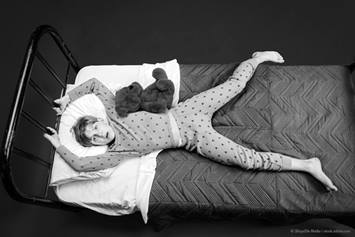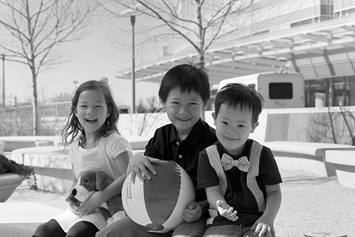Apnea
Apnea is a pause in breathing that lasts 20 seconds or longer for full-term infants. Most infants outgrow this problem by the time they are a year old.
What Is Apnea?
Full-term means your baby was born after 39 weeks of pregnancy. Normally, the brain controls breathing automatically. During sleep, when the brain is less active, breathing and how fast the heart beats (heart rate) slow down. It’s normal for infants to have short pauses in breathing. In infant apnea (ap-nee-uh), these pauses are too long, and the heart slows down too much. This is more common in premature babies born before 37 weeks.
Apnea is a pause in breathing. It can happen quickly, without warning. Apnea has one or more of these signs:
- Not breathing for 20 seconds or longer
- Skin color becomes blue or very pale (cyanosis)
- The heart beats more slowly, less than 80 times in a minute. This is called bradycardia (bray-duh-kaar-dee-uh). Bradycardia often follows apnea.
Most infants outgrow apnea by the time they are 1 year old.
Apnea should not be confused with or linked to sudden infant death syndrome (SIDS). Unlike apnea, doctors cannot predict or know why a baby will have SIDS. With apnea, sometimes the doctor can find out why it happens and can recommend a treatment.
What Causes Apnea?
There are many different reasons a baby may have apnea.
- Brain immaturity – The brain does not send the right signals to the body to breathe when it should. The brain needs to grow more.
- A heart problem – The heart doesn’t pump enough blood to the brain to trigger it to send a signal to breathe.
- Infection – There is a urinary infection or an infection in the lungs or brain.
- Acid reflux – The baby’s food and stomach juices keep coming back up into their esophagus (the tube leading from the mouth to the stomach).
- Other medical problems like lung disease, anemia (low oxygen in the blood), or a genetic (born with) problem.
- Sometimes, the doctor cannot find a reason for the apnea.
How Is Apnea Diagnosed?
Your child will be admitted to the hospital.
- The doctor and health care providers will watch their breathing to learn what happens before, during, and after the apnea occurs.
- A pulse oximeter will be put on their hand or foot. This device monitors the amount of oxygen in their blood and their heart rate.
- Their blood and pee (urine) will be tested.
How Is Apnea Treated?
Even if the cause of your baby’s apnea can’t be found, there are some things that can help.
- Give medicines that help your baby breathe and increase their heart rate.
- Give your baby oxygen through little tubes called cannulas that are placed in the nose.
- Pre-term babies might need a machine that breathes for them (a ventilator).
FDA Warning for Medical Device Tubing
- The medical device tubing can get wrapped around a child’s neck. This can lead to choking (strangulation) or death.
- DO NOT leave the medical device tubing where infants or children can get tangled
up in it. - Talk to your child’s doctor or health care provider:
- If your child has been tangled in their tubing before.
- To learn steps you can take to help make sure the tubing does not get wrapped around your child’s neck, such as keeping the tubing away from the child as much
as possible. - Any other concerns you may have about the risk of strangulation from medical device tubing.
- If your child is injured by the medical device tubing, please report the event to the FDA. Your report can provide information that helps improve patient safety. The FDA website to make a report is: https://www.accessdata.fda.gov/scripts/medwatch/index.cfm?action=reporting.home
Going Home
Apnea in infants is usually temporary. Most babies outgrow it in a year. If your child is sent home with any medical devices, they can help prevent complications, but they will not make your child’s apnea go away any faster.
- Your child may be sent home with a pulse oximeter. The health care team will teach you what to do if the alarm rings.
- Your child may need to get oxygen through a nasal cannula (See FDA Warning).
- The health care team will teach you how to make your baby’s home environment as safe as possible.
- Do not let anyone smoke in your home, car, or anywhere near your baby.
- Follow the ABC's of safe sleep.
- Alone - Babies must sleep alone. It is okay for them to sleep in the same room as you or others as long as they sleep in their own sleep space like a crib or bassinet.
- Back - Always place your baby on their back to sleep. This is the safest position.
- Crib - The crib must be empty. Do not put bumper pads, pillows, blankets, stuffed animals, toys, or supplies like diapers and diaper wipes in their crib.
- If your baby can use a pacifier, it might reduce the risk of apnea.
- You may need to learn infant CPR if your baby stops breathing at home.
Helping Hands Patient Education Materials
Written and illustrated by medical, nursing and allied health professionals at Nationwide Children's Hospital, Helping Hand instructions are intended as a supplement to verbal instructions provided by a medical professional. The information is periodically reviewed and revised to reflect our current practice. However, Nationwide Children's Hospital is not responsible for any consequences resulting from the use or misuse of the information in the Helping Hands.
HH-I-10 | ©1984, revised 7/22, Nationwide Children’s Hospital



